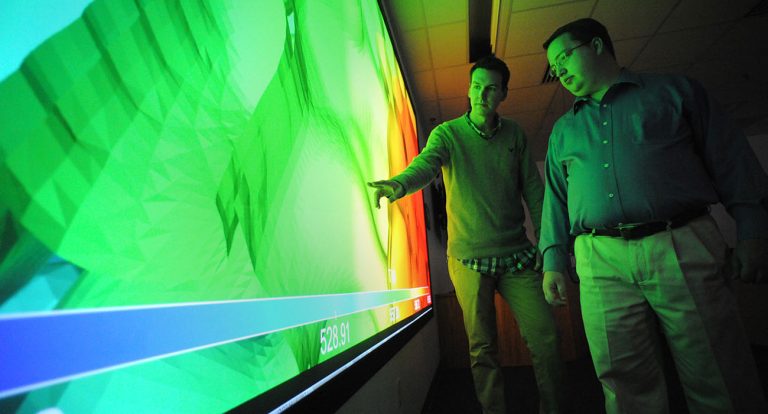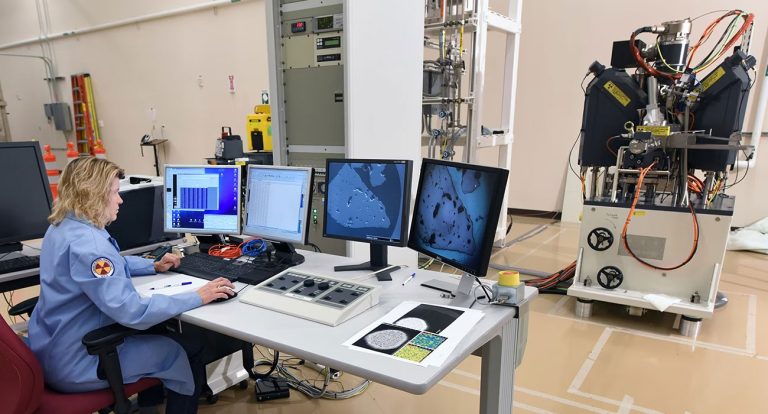Advanced Nuclear Fuels
Next-generation nuclear reactor fuels are designed to be more efficient and exhibit accident tolerant characteristics. To test and confirm such assumptions, INL scientists are working with collaborators around the world.
INL has led a fundamental shift in how nuclear energy research and development is approached. Lab scientists integrate fundamental research, modeling and simulation, small-scale experimentation and larger scale demonstrations, which are coordinated with industrial and international partners.
Capabilities and Programs
Advanced Reactor Technologies (ART)
Advanced Reactor Technologies (ART) is a national program funded by the U.S. Department of Energy (DOE). At INL, work is focused on developing a High Temperature Gas-cooled Reactor (HTGR), a modular, advanced reactor. By nature, this reactor design enables plants to scale the number of reactor modules with consumer demand. Additionally, this reactor produces excess heat, making them a perfect partner with other industrial plants who can use this heat for their own production processes.
Advanced Nuclear Reactor Siting
INL has a full complement of capabilities to respond to today’s nuclear energy challenges, serve as a multiprogram laboratory with competencies in energy and national security, and address future challenges.
With these capabilities, INL is poised and ready to house advanced reactor demonstrations.
Advanced Modeling and Simulation
INL’s Multi-physics Object Oriented Simulation Environment (MOOSE) has gained broad recognition and a large user base, revolutionizing predictive modeling work in an array of scientific fields. Its simulations can help inform real-world experiments, and researchers no longer have to be computer science experts to tackle state-of-the-art simulation.

New Fuel Concepts
INL scientists are researching nuclear fuels that are more tolerant to accident conditions, utilize energy resources more efficiently or leave fewer long-lived waste isotopes behind. For example, tristructural isotropic (TRISO) fuel has several layers of carbon and carbide that serve as the primary containment for radioactive material. INL scientists led work setting a global performance record for the fuel (19 percent uranium use) , and demonstrating that it can withstand extreme temperatures (1,800 degrees C).
Molten Salt Reactors
Molten salts are a diverse group of fluids that can be used for a variety of applications, including nuclear fuels and coolants, purification and separation of chemical species, and energy storage. INL is studying and solving complex issues associated with advanced energy production and used fuel management for effectively and safely deploying future energy solutions.

Fusion Safety Program
Thermonuclear fusion powers the Sun and the stars and is the most powerful energy source known. Harnessing this power on Earth will benefit mankind for ages to come. Its energy would be cleaner, more secure and more economical than any of today’s power sources. INL has been involved in fusion research for over 30 years in support of the Department of Energy’s (DOE) mission of seeking clean, safe and economic fusion energy. The INL’s Fusion Safety Program (FSP) is the Office of Fusion Energy Science’s (OFES’s) Lead Laboratory for Magnetic Fusion Energy (MFE) Safety. In this role, the FSP pursues a safety research program that maintains several core competencies. For details, visit the Fusion Safety Program website:
One-Stop Experiment Shop
When real-world experiments are needed to validate models and simulations, INL’s distinctive capabilities provide a one-stop-shop. The lab has specialized facilities (many unique in the nation) for designing, fabricating, testing and characterizing advanced nuclear fuel concepts.

